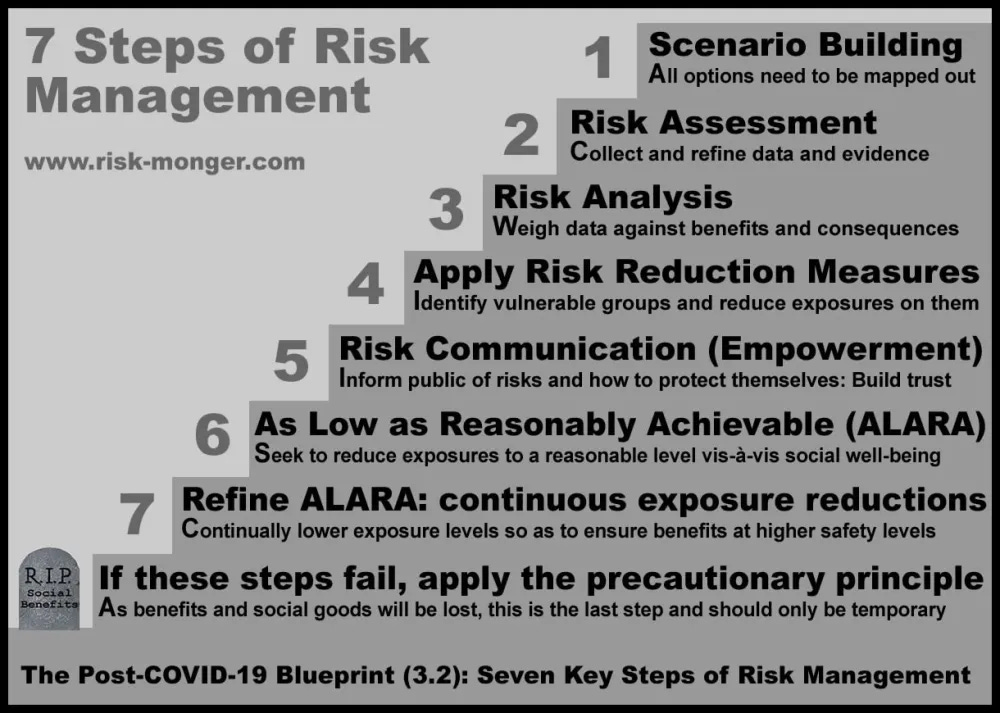A European White Paper on Risk Management
How to make EU policy rational and workable
This is a follow-up of my previous article concluding that European decision-makers no longer have the regulatory sophistication to manage a major policy process. For Europe to remain a credible regulatory force, Brussels needs to establish a set of rules or guidelines (via a White Paper) on how risks should be managed. Here is a one-pager to begin a discussion with European policy leaders on EU policy reform. See a longer version here.
You know how to find me!
From the moment we put one foot out of our beds, we are engaged in the risk management process. All governance, policymaking and leadership, all decisions, are based at a fundamental level on assessing and managing risks.
The European Union does not have a coherent strategy or articulation of what the risk management process is. The precautionary principle (uncertainty management) has often been confused as the key risk management tool while it should only be used as a last resort when all risk management tools have failed to protect populations while delivering goods and services.
As the European Commission has used precaution as the only option for its environmental-health regulations, EU policy discussions denigrate to how many goods and services could be removed without completely destroying economies and livelihoods. For example:
in energy policy, how many fossil fuel sources should be decommissioned;
in pesticide policy, how many substances can be banned without yields collapsing;
in transport and climate policy, what is the shortest time to eliminate internal combustion engines…
This is not risk management or good governance; this is not enabling economies to innovate and deliver goods and services to its populations; this is managed decline with little regard for consumers, economies, investors, trade or research.
Attempts to improve the EU governance process should no longer try to focus on Better Regulation, but rather to develop a clear risk management strategy. Europeans need to have a well drawn out guidance document – a White Paper – on risk management. This White Paper should serve as the reference point for all environmental-health policy decisions.
Some examples of EU failures in risk management
The hazard-based approach applied in the Sustainable Use of Pesticides Directive has left most crop protection substances facing removal from the market. Products are being banned with no viable alternatives for farmers.
The EU has shown a failure to conduct proper risk assessments based on relative exposures and harm reduction measures (eg, on e-cigarettes, chemicals or plastics).
The precautionary ban on neonicotinoids was made without a risk assessment and prior exposure-reduction measures. EU leaders chose to ignore a study its own Joint Research Centre (JRC) produced, warning the Commission of the risks of their policy.
Certain EU Green Deal measures (Farm2Fork, Fit for 55…) to reduce CO2 emissions fell into the risk-risk trap, with no reflection or dialogue.
The COVID pandemic was mismanaged, from the failure to use the early months to contain the spread to vulnerable populations, the inability to obtain PPE, poor risk communications (eg, the Astra-Zeneca vaccine precaution scandal) and the rush toward precautionary lockdowns.
This European White Paper, perhaps led by the JRC (with support from ECHA and EFSA), would be the baseline for any clear, transparent governance process, establishing a guidance document to prevent politically-oriented civil servants from using tools like the precautionary principle or the hazard-based approach to manipulate policy.
This White Paper would address the following points:
What should be in a risk management toolkit (what should and should not be used in the policy process).
A clear definition of precaution (the Rio Triple Negative vs the EEA reversal of the burden of proof) and its situation within the risk management process.
A distinction of the hazard-based approach from the risk-based approach and their roles within the risk management toolkit.
Articulation of the risk management process (see image above), moving from hazard identification to risk assessment to scenario building to risk communication to hazard reduction measures to risk-benefit analyses … and only if this process fails to provide protection, conditions for invoking the precautionary principle.
Guidance on the types of questions provided to risk assessors and follow-up best practices (as well as the ability for risk assessors to widen or narrow scope).
Clarification of the role of science, evidence and research within the EU policy process.
Timeline for publishing risk assessments, reports, studies and risk communication guidelines.
A coms strategy for reducing European risk aversion (tied to an EU innovation strategy).
The reality is that few actors in Brussels would want such a document. Regulators, lawyers and activist groups prefer the loose ambiguity of an ill-defined, ad hoc collection of policy tools that could be cherry-picked when the interest arises. Those championing a post-capitalist, degrowth ideology favor the managed decline approach precaution provides. But researchers, investors and commercial organizations need the certainty and rationality of a coherent policy process in order to make significant commitments and investments. These groups, perhaps around a Brussels think-tank, need to push the European Commission to launch this White Paper.



